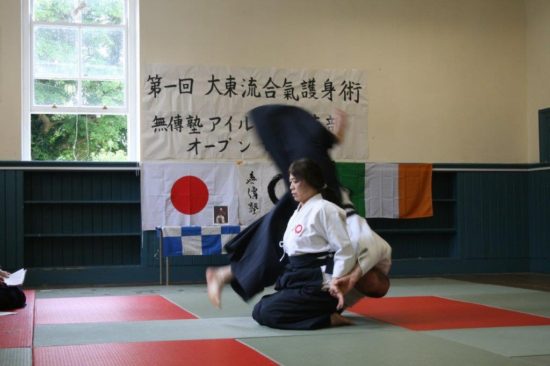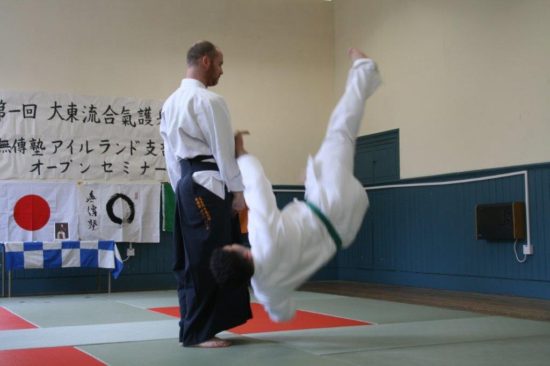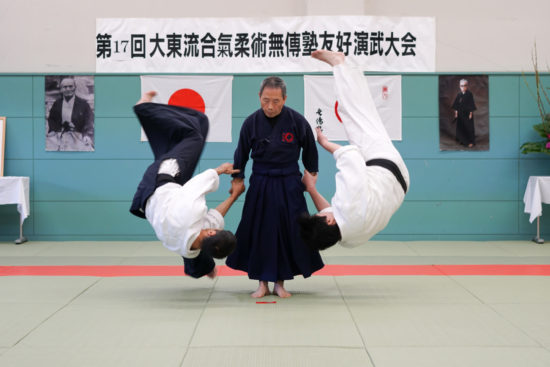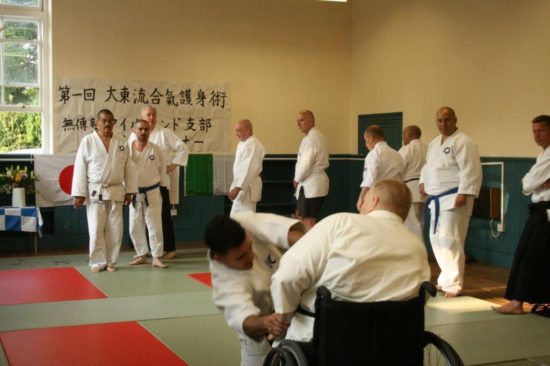大和田善正 六段
【連絡先】℡:070-4425-0170 メールアドレス:worldmap2000.com@gmail.com
※東京に在住しています。
合氣体になってきたかは、合氣之術(ふっつき之術)ができるかの成否を眼目とする。
羽交締め
投げると取の身体に纏わり付いて極固められている。
「無傳之閉足(むでんのへいそく)」だから・・・。

【連絡先】℡:070-4425-0170 メールアドレス:worldmap2000.com@gmail.com
※東京に在住しています。
合氣体になってきたかは、合氣之術(ふっつき之術)ができるかの成否を眼目とする。
羽交締め
投げると取の身体に纏わり付いて極固められている。
「無傳之閉足(むでんのへいそく)」だから・・・。
無傳塾のDVD第2巻(BABジャパン制作・2012年7月31日発売)に掲載された口上文です。
【無傳塾DVD第二弾 口上文】
明治31年(1898年)5月12日、今から114年前のこと。
会津士族武田惣角源正義は旧会津藩主の松平容保の臨席のもと元筆頭家老の西郷頼母(保科近悳)から藩外不出の御留流であった殿中武芸護身術「御式内」(大東流合気柔術の中核)の相伝印可を授与された。
その折、容保からは旧会津藩において恩賞として高録の藩士に与えられていた紫の羽織紐が惣角に下賜された。また、西郷頼母近悳からは「知るや人、川の流れを打てばとて、水に跡あるものならなくに」という和歌一首が贈られた。
戊辰戦争に敗れ朝敵の汚名を着せられた会津藩は、何を思い惣角に何を託したのであろうか。
まずは、この汚名を返上すべく旧藩主は「会津藩秘伝の平法」を世に知らしめ、会津武士の威信回復を切望していたのであろう。つまり、惣角は“藩命”として身命を賭して「大東流合気柔術」の全国指導普及の行脚を始めたのである。
さて、朝敵の汚名返上の好機が到来した。昭和3年(1928年)9月28日、松平容保の四男で外交官を務めた松平恒雄の長女である節子と秩父宮雍仁(やすひと)親王(昭和天皇の弟)の御成婚である。
孝明天皇の信頼を得ながら明治維新で朝敵とされた容保公は節子にとって祖父にあたる。戊辰戦争では白虎隊の悲劇を生み、藩士らも流罪に等しい労苦を強いられただけに旧藩主の孫娘の皇室入りに地元は「会津の復権」に沸いた。幼名は節子であったが大正天皇の皇后である貞明皇后の旧名は九条節子(くじょうさだこ)であり同じ字では恐れ多いため、御成婚により会津の“津”をとって「勢津子」と改名された。勢津子妃は、父恒雄の任地であったイギリスのロンドンで生まれ、日英協会名誉総裁。秩父宮雍仁親王はオックスフォード大学に学び、英国とは浅からぬ縁があった。
明治36年(1903年)、米国からプロレスラーが来日、仙台警察署において2名が惣角に試合を挑み完敗した。当時、米国より派遣され来日していた英語教師チャールズ・ア・バリーは、帰国してセオドア・ルーズベルト大統領に報告して知るところとなり、大統領の要請により惣角の代理として原田信蔵を派遣渡米させ普及している。
大東流中興の祖である武田惣角から手解きを受けた門人は明治・大正・昭和の三代にわたり多士済々であり、大正14年に竹下勇海軍大将、昭和9年に岡田啓介総理大臣らには「試される大地・北海道」から惣角が指導に出向いている。こうして蒔かれた合気の種が芽を出して、百余年を経て大東流合気柔術を源流とする合気道は広く世界に流布、日本を代表する伝統文化の一つとして開花したのである。
今日、世界における武道人口のランキング上位は、1位が空手、次いで柔道、そして3番手が大東流を源流とする合気道と続いている。
北海道における会津藩ゆかりの地として、会津藩祖の保科正之公を土津霊神(ハニツレイシン)として祭祀する琴似神社が札幌市郊外に鎮座している。正之公は徳川二代将軍秀忠の側室の子にして、四代将軍家綱の輔佐役(大政参与)、異母兄である三代将軍家光から松平姓と葵紋の使用を認められていた名君である。明治初年より多くの旧会津藩士たちが士族移民として北海道開拓に尽力している。
もともと御式内(合気の原典)の宗師家は会津藩主が代々これを継承しており、大東流も合気道も同じ伝承系譜から輩出されたものである。
日本古来の精神の武術「大和心の武道」ともいえる大東流は偉大なる無形文化財と言っても過言ではない。
かつて会津藩の所領であった福島県は明治維新による戊辰戦争の屈辱に加え、平成23年3月11日に発生した東日本大震災の苦難に見舞われている。福島県民の皆さんには、このような大いなる無形文化財を育んだことに誇りを持っていただきたい。
この未曽有の大震災により人々の絆を強めている昨今において、大東流と合気道の斯界もこれを機に各流会派の独自性と特色を尊重しつつ、それぞれが謙虚になり和合の道を見出して互いの絆を強めるべきではないだろうか。
会津で代々培ってきた大東流合気の花、その花を武田惣角は北海道に根付かせた。日本全国さらに世界へとその花の種は蒔かれ「大和心の武道」の花となって咲き始めている。それぞれが手を取り合い強い絆のもと、日本の素晴らしいこの文化遺産を世界に向けて発信していきたい。
(敬称略)
世界とつながり絆を強めよう!
平成24年(2012年)3月11日

第八回會津鶴ヶ城古武道祭での演武
平成25年9月22日(日)会津鶴ケ城本丸特設ステージで大東流無傳塾も演武致しました。

保科正之公御鎮座
国指定史跡土津(ハニツ)神社
保科正之公は大東流合気柔術を御式内(殿中護身武術)と定め会津藩の御留技とした日本国の名君といわれた方です。
→
動画撮影:İlkay İtkü
イルカイさんがビデオを撮影してくれていたので、彼の承諾を受けて無傳塾ウェブサイトにも掲載させてもらいました。
2019年 元旦
いい氣 いい出会い いい仲間づくり
Good energy Good enccounters Good relationships
合氣護身術大東流無傳塾
塾長・最高師範 飯田 宏雄
入り身投げ
前進あるのみ
数年前、海外に行ったことで、日本人らしさとは何か、自分は日本人として何ができるのかと考えた時、何も持っていなかった。このままではいけないという焦りのようなものがあった。そんな中、出会ったのが無傳塾だった。女性や子どもでも対等に稽古できる、呼吸できれば誰でもできると聞いて、これなら運動嫌いの自分にもできるかもしれないと思った。それに、道場のピリッとした空気が妙に心地よく、稽古の様子、何より袴姿が格好良かった。ぼんやり思い描いていた“日本人らしさ”とは、これだと思った。始めは何もかも新鮮で面白かったが、やるほどにわからなくなってきて、仕事や体の不調でと、自分に言い訳をして足が遠のいた時期があった。しかし、実際に稽古に行くと、体がすっきりして、翌日は仕事がうまくいく。「通うことが修行」。今でもこの言葉を戒めにしている。
合気柔術に通うようになってから、普段の生活で、コミュニケーションをとることが以前に比べて円滑になったように思う。合気と同じように、力でぶつからず、相手と繋がる。これを取り入れてみると、なんとなく苦手だなと思っていた人でも、最初からシャットアウトせず、まず、向き合ってみようという気持ちになれる。
最近になって、座る、立つ、歩く基本の動作がとても難しい事に気づいた。稽古の回数が少ない分、いかに日常に落とし込むか意識するようにしている。地下鉄に乗るとき、仕事中など、気づいたときに肚に力を入れている。
これからの目標はまだ漠然としているが、飯田先生のように、いつまでも進化していけるよう、精進していきたい。
初段 野口 華代
第18回の演武大会は松浦武四郎が北海道と命名してから150周年の節目の年にあたり、無傳塾もこの150周年事業の協賛に参加しています。今大会はその協賛事業の一環に当たる大会になりました。
また、2020年はオリンピックの年であります。この2020年には国内外の方々に呼びかけて国際大会を札幌で開催する計画をしているところであります。そのために今年の6月にはアイルランドへ、9月にはアメリカでセミナーを開いて2020年に札幌に来てくださいと行脚して参りました。手応え充分と感じ取った次第であります。
2020年に向けてこの演武大会を少しでも大きくしていきたい、夢の大舞台に仕立てたいと願っています。
広く各流会派の参加を呼びかけています。
ニュージャージー(N.J.)支部で2回目のセミナーが2018年9月8日(土)・9日の2日間にわたり開かれました。
カンサスのダグペリンさん(Doug Perrin)が来てくれて、友好を深めることがで出来たことはとても嬉しく思いました。
以前にカンサスセミナーの折り、ダグペリン宅にホームステイをして、大変お世話になりました。
ダグペリン宅で、朝に小鳥のさえずりを聞きながらとても和んだ素晴しい合気の稽古をしたことが思い出され、とても懐かしくなりました。
この機にRayさん(N.J.)とDougさん(Kansas)とが一緒に活発に交流稽古されることを期待しております。
N.J.支部はRayさんの指導の下、確実にレベルアップされていることが心強く感じられたセミナーでした。
飯田師範が大東流を学んで早50年。
これを記念して審査会を開催しました。
門弟たちが、のびのび健やかに成長している姿が見てとれ、とても頼もしく感じられます。
札幌市西区体育館 2018年10月28日(日)
稽古三昧
奥義参段:片野美和子
奥義参段:片野淳彦
奥参参段:南出憲宏
奥義参段:湯浅拓幸
後技:抱きつき合気投げ
奥義参段:布施陽菜
初段:野口華代
胸取り諸手つかみ合気投げ
参段:山下啓子
A unique event took place in the village of Thomastown, Kilkenny this June. It was the venue for the first ever Irish seminar in the traditional Japanese art of Daito Ryu Aiki jujutsu. Moreover, this seminar also had the distinction of being taught by two instructors from two ryu ha (factions) of the art: Hiroo Iida, a shihan (master level) instructor and lineage student of Kodo Horikawa, and Ole Kingston jun kyoju dairi,(licenced teacher), lineage student of Okamoto Seigo shihan, one Horikawa’s earliest and highest-level students. These two instructors presented methodology stemming from a common source, but they also showed distinct aspects of the Daito ryu that informed each other. Practitioners were thus able to receive a comparative, broad and comprehensive overview of the principles of this fascinating art.
Traditional Japanese ‘ways’ of development and art, whether they are budo (ways based on martial practice) shodo (based on calligraphy) chado (based on the tea ceremony) traditional dance or one of a myriad of other practices, must be experienced bodily and mentally in order to fully understood their depth. In this age where people can become ‘experts’ from watching clips on the internet and picking and choosing bits of different arts to bolster their own system to attract students, fewer people are actually taking the opportunity to train with truly advanced practitioners of budo to a deep level. This has been a perennial problem in learning traditional arts. The Japanese writer Issai Chozanshi addressed this tendency in the early eighteenth century in his classic treatise “The Demon’s Sermon on the Martial Arts”. Chozanshi wrote
“Nowadays, people are shallow and their resolution is not in earnest. They dislike the strenuous and love the easy from the time they are young. When they see something vaguely clever, they want to learn it right away; but if taught in the manner of the old ways, they think it not worth learning. Nowadays, the way is revealed by the instructor, the deepest principles are taught even to beginners, the end result is set right out in front, and the student is led along by the hand.”
This is a problem in Ireland as much as anywhere else, so I organised this seminar to help remedy this situation.
Attendees came to Thomastown from all around the world to avail to the experience to train with Ole and Iida Sensei. Countries represented at the seminar included Japan, the USA, Denmark, Portugal, Britain, France, Finland, Belgium and of course Ireland. Practitioners came from a background of a variety of arts, including various Ryu ha (branches) of Daito Ryu, Aikido, Koryu Bujutsu (classical Japanese martial disciplines), Jujutsu and Chinese arts. The fact that such a diverse group of people managed to train so well and profitably together over a weekend seminar is a testament to the spirit of all those who attended and to the ability of the instructors.
The days were split between morning sessions, led by Ole Kingston, and afternoon sessions, led by Iida Hiroo, with an introductory session being held on Friday evening.
Ole’s main emphasis for his sessions were on the aiki jujutsu portion of the art. These included techniques that used sophisticated methods of timing, breathing, use of the eyes and intent to effect kuzushi (the breaking of balance) on the opponent. In aiki jujutsu, little physical effort is needed to disrupt the opponent’s balance or will to attack. Minimal movements are focussed on specific areas of the opponent’s body, often the joints, known in Japanese as kansetsu waza. Ole sensei also taught very much by feel, throwing everyone in attendance in a line (known as rinban keiko in Japanese).
Then we divided into three smaller lines to practice the techniques with each other. The emphasis was on smoothness and repetition of execution. Ole often showed ‘sets’ of techniques, which were basically the same techniques done for a particular attack (e.g. a one-handed grab) but were executed using different modes of movement, from relatively large and expressive to small and refined. One reason for this kind of training was to help ‘burn in’ the smoothness of the movement needed to do the techniques correctly. Also, by repeatedly recieving these techniques in a line, one could feel the movements within one’s body feel where their balance was disrupted.
A special emphasis on Ole sensei’s classes was achieving this smoothness in executing techniques, which is based on a deceptively simple principle called ‘no-shi’. This is a kind of spiral motion that is expressed by the hands but is ultimately created by the correct use of the whole body. It’s a multi-faceted concept that applies to many aspects of practice, such as breathing and body usage. Ole demonstrated that the first part of this movement (‘no’) unbalances the opponent and can even momentarily stop their breath, while the second part (‘shi’) follows the technique through to the end either as a throw, lock, strike and so on. However, these should be executed as two aspects of the one movement! Even in this basic teaching there was a wealth of practice and information for people to work on.
Ole’s teaching was at a very sophisticated level. The aiki jujutsu level of the art is rarely taught and demonstrated so clearly, especially to first time practicioners. Iida sensei’s portion of the seminar extended that sophistication to encompass the aiki no jutsu portion of the art.
The Three levels of Daito Ryu: Soden, Chuden and Okuden.
This three-level stage of training is quite common in many authentic Japanese arts. In the practice of shodo (Japanese calligraphy) for example, practitioners begin by practicing brushing script in the Kaisho level. The script that practitioners brush/write at this level are characterised by strong clear and precise strokes. Then they move onto gyosho in which the brushwork becomes more fluid as practitioners begin to grasp how the characters in Japanese script work and fit together. Finally, after many years of practice, master level calligraphers achieve the level of sousho, in which their calligraphy and their vital energy becomes fused into their work.
Traditionally, when one joined a Daito Ryu school, one moved through three levels of initiation. The first level of this was the soden level at which practitioners learned jujutsu. This included powerful locks throws, groundwork and strikes (known as atemi) that were not dissimilar from other schools of Japanese jujutsu. After a period of training, (up to ten years), practitioners were graduated to chuden level and were introduced to the aiki jujutsu portion of the art. At this level, jujutsu techniques start to be performed using aiki, as opposed to normal muscular strength. At this level, many of the techniques became smaller, and thus could be performed in smaller spaces. Aiki jujutsu techniques lock up or throw the opponent by attacking their joints momentarily with aiki. Aiki is a deep concept for which there is no English translation, but it incorporates elements of breathing, timing, reflexes, psychology and body movement. Finally, some of the most advanced practitioners of Daito Ryu graduated to the okuden level of the art and learn the techniques known as aiki no jutsu. This is a level in which the internal practices introduced at the chuden level have become so integrated into the practitioner that the practitioner barely moves externally. Internally however, the practitioner is using intent, breathing and connection to organise themselves to deal with incoming force and to generate unified, compacted energy. The opponent is unbalanced, locked up, thrown or even frozen, cramped or compacted at the moment of contact, often before they are even aware of what has happened.
At the level of aiki no jutsu, the sharp aiki techniques used to attack joints at chuden level flow into the opponent’s whole body. The sensitive opponent grabs or attacks, but suddenly feels like a huge powerful force suddenly appears somewhere within them, sometimes feeling like a great weight, sometimes like an uprush of wind and sometimes like an explosion, all going on deep within their body. Often when receiving an aiki no jutsu technique, a beginner will fall or lose their power without being able to understand what has happened to them. It feels as if they just fell over. To the outside observer, it certainly seems like nothing is happening between uke (the attacker) and tori (the thrower). This is linked to the historical development of the Daito Ryu style, which evolved as an art special to the Aizu samurai clan of Northern Japan. High ranking members of the Aizu used the art as a self-defence art for formal indoor situations. These situations demanded minimal movement and a calm, settled spirit, steady breathing and a highly developed usage and control of one’s body and mind.
Iida sensei’s section of the seminar concentrated on the aiki no jutsu portion of the art. He emphasised the type of practice required to develop this level of the art. He stressed the importance of correct form or kata in practice. This type of kata geiko requires often repetitive, mindful attention on the part of both uke and tori as one starts to integrate breath, intent and internal connection need to neutralise and redirect uke’s incoming force.
To this end, we concentrated on the first day on a series of paired practices to develop aspects of the body, in particular the chushin, or centre line. This central line of the body must be unified for the aiki no jutsu level techniques to make sense. This is because aiki no jutsu techniques cannot utilise normal, gross muscular power due to their minimal movements. Grasping this concept must be done on a physical and mental level and this requires special training method. Iida sensei also explained the crossover with these principles found in some schools of Japanese swordsmanship, or kenjutsu. Iida sensei made mention of kuden, or oral teachings in traditional arts to help inculcate the correct movements and body usage based on the principles expressed in natural. Iida sensei’s emphasis was not on the large, dramatic movements that many identify with Japanese budo arts. Instead, he concentrated was on developing a soft yet connected, concentrated body and mind that could gather and express aiki. For Iida sensei, this is the essence of Japanese arts and their training methods, akin to and ‘old style’ or ‘koryu’ method of movement and training.
On the final afternoon, Iida sensei introduced some techniques that could be executed with minimal movement in order to help manifest aiki no jutsu in application.
The approaches of both teachers helped inform the other. Where Iida sensei’s emphasis was on development, Ole’s was on expression. Where One approach helped make one aware of movement, the other made you more aware of internal connection. Where one emphasised the feeling from receiving a technique, the other emphasised the cultivation of feeling in oneself. Both approaches gave insights to practitioners that weren’t usually shown. More importantly, the feelings, concepts and body organisation introduced will hopefully provide a foundation from which attendees can develop for years to come. Many concepts introduced were very high level and left some practitioners conceptually confused, yet I believe that the training planted seeds within the body of each attendant that will bear fruit in years to come. My sincere thanks to everyone who attended this unique event, and my commiserations to those who missed it!
Biography of the Author.
Oisin Bourke is a shibucho (branch director) for the Ireland branch of Muden juku, a group that practices traditional Daito Ryu Aiki jujutsu under the auspices of Hiroo Iida, Shihan. The headquarters of the Muden Juku is based in Sapporo, Japan. Oisin Currently holds the rank of Fourth Dan in the art and teaches at a dojo in kilkenny, Ireland along with Megumi Bourke, who holds the rank of Okugi Sandan (inner level third dan).
He can be contacted at oisinobrienbourke@gmail.com
Or at facebook at https://www.facebook.com/MudenJukuIreland/?ref=bookmarks
The Irish web site is located at http://oisinbourke.wixsite.com/daitoryu

A practitioner of Daito Ryu Muden Juku Ireland Branch, Megumi Bourke, demonstrating a technique. Using aiki, one does not need to rely on brute strength. Daito Ryu techniques are therefore beneficial for men and women of all ages.

Daito Ryu Muden juku Ireland Branch member Oisin Bourke demonstrating an aiki technique for his Fourth Dan (Yon Dan) grading demonstration. Correct posture and use of body is vital at this level.

Hiroo Iida, shihan of Daito yu Muden juku demonstrating a two person throwing technique.

Practicing an exercise to develop chushin (center line) connection while iida Sensei looks on.

Ole Kingston sensei teaching and demonstrating an aiki jujutsu throw participants in line practice (rinban keiko).
↓ Megumi Bourke 動画
セミナーレポート
無傳塾アイルランド支部第一回オープンセミナー
飯田宏雄 、オーレ・キングストンを迎えて
キルケニー・トーマスタウン
2018年6月
2018年、6月アイルランドのキルケニー州、トーマスタウンという小さな村で、初めての大東流合気柔術のセミナーが開催された。今回のセミナーは2人の講師、一人は日本から堀川幸道先生の直弟子で無傳塾最高師範の塾長飯田宏雄氏、もう一人は、同じく堀川幸道先生の初期の高弟である岡本正剛先生に師事し日本人以外で最も長く修行されたデンマークのオーレ・キングストン氏。この二人が受け継いだ大東流をそれぞれ異なった視点で捉え、教えるといったユニークな試みが実現し、参加者たちはこの大東流という日本の武道の原理を深くそして包括的に比較しながら学んでいくという機会に恵まれた。
大東流で特に印象付けられるのが、他の日本の伝統芸術にあるように、習う者は言葉で教わらない、概念で教わるのではなく、とにかくやる。それが、日本流の上達の仕方であり、武道にしても、書道、茶道、日舞など無数の伝統芸術を学ぶ者は、これをよく理解して、楽しみながら上達をしていっているに違いない。今の世の中、インターネットのクリップを見て欲しいところだけ取り出して自分流に加工して誰でも“エキスパート”になれるご時世。アイルランドに限らず、世界中で起こっているこんな現象を少しでも解消するべく、たとえ、ほんの少人数でも本物の武道の熟練者からレベルの高い稽古を受けるという機会を与えることが出来たのは嬉しい限りである。
今回のセミナーには、日本、アメリカ、デンマーク、ポルトガル、イギリス、フランス、フィンランド、ベルギー、そしてアイルランドからたくさんの参加者が集まってくれた。参加者は、さまざまな大東流の流派、合気道、古流武術、柔術、中国武術など多様な武道の経験者でこれだけたくさんのバックグラウンドの人たちが集まったにも関わらず、結果的にこの短期のセミナーで有益な時間を過ごすことが出来た。
今回、土曜・日曜を午前、午後と2セッションに分けて、午前をオーレ先生、午後を飯田先生が受け持ち、金曜の夜2時間は、初日のイントロデュース(紹介)となった。
オーレ先生が今回のセミナーで強調したのは“合気柔術”。これには、洗練した捌きのタイミング、呼吸法、崩しに有効な目の使い方なども含まれた。合気柔術では、少ない力で敵(受け)の攻撃を止めることが必要である。最小限の動きは、敵(受け)の特定の箇所、主に関節に集中して崩す。オーレ先生は参加者全員を一列に並べて次から次へと技をかけていった。(輪番稽古)
そのあと3列の列を作り、同じように輪番で稽古をした。ここで、オーレ先生が強調したのは流れるようにスムーズに繰り返しやること。オーレ先生はたびたび“セット”で技を披露した。“セット”というのは、受けがある攻撃(例えば片手掴み)をしてきた時、基本的には同じ技なのだが、微妙に違った動きで、大きなものから洗練された技まで変化させて見せた。輪番の意図するところは、何回も同じことを繰り返すことで考えなくても無意識のうちに体が動かせるようになること。正しく技をかける、そして受けは体のどこが崩されたかを感じ取ることが出来るか、ということ。
今回、オーレ先生が強調した“(流れるような)スムーズさ”というのは、「のし」と呼ばれる動き。受けの攻撃を欺くシンプルな原理で、腕をらせんを描くように(日本語の「のし」と書くように)動かすのであるが、これは究極的には体全体を正しく使うためにする動きである。これは、多くの要素を含んだ多面性のあるコンセプトで、例えば呼吸法や体の使い方など様々な方向に適用される。オーレ先生は、最初のパートの「の」で相手のバランスをとると同時に瞬時に相手の呼吸も止めることが出来る事をみせ、次の「し」のパートで投げるか、固めるか、打つなどいろいろな展開が可能であると披露した。本来これらは1つの動きの中にあるものなのだが。この基本技の稽古は、参加者にとってとても有益なものになったと思う。
オーレ先生の教えは洗練されていて、特に合気柔術はあまり詳しく説明したり、見せたりしないので特に初心者にとってとても意義のあるセミナーだったと思う。飯田先生のセミナーでは、さらにこれを高度化した合気之術へと発展した。
日本の古流と呼ばれるものを習う時に、この3つの段階、初伝、中伝、奥伝は一般的である。例えば書道を例に挙げると、最初は楷書を習う。筆の使い方、運び方、筆順など文字を書く時に必要な基本をきっちりした書体で書くことで身につける。次に楷書を少しくずした、行書。そしてさらにくずした草書と発展していくが、単に書体の変化だけでなく、何年もかけて稽古を重ねることでやがて書き手の心と体が質の高いものになっていく。
古来、大東流では入門から3段階のレベルがある。初めは初伝でこれは柔術にあたる。厳しい関節技や投げ、当身(あてみ)と呼ばれるつきなど、他の柔術と呼ばれる流派と似ていなくもない。それらの修行を積んで(だいたい10年ほど)中伝と呼ばれるレベルになる。これは合気柔術になる。このレベルになって筋力とは違う合気を使い始める。技の動きは小さくなり、技をかけ合うのも少しのスペースでよい。合気柔術の技は瞬時に合気で敵(受け)の関節を責めて崩す。合気の概念は英訳するのが難しいのだが、呼吸、タイミング、反射、心理的、体の動き、これらの要素がかみ合わさったもので構成されている。
そして、最後に奥伝レベルと呼ばれる合気之術へと進化する。これは、中伝レベルで取り入れていく内家を鍛える稽古の末、体はほんのわずかに動くだけである。内家だけれども、取りは意識的に呼吸法と、攻めてくる力とぎっしりと詰め込んだエネルギーを一つにまとめる。受けは掴んだ瞬間にバランスをとられ、投げるか固まるかされる。ほとんどが何が起こったか分からないほどの速さである。
合気之術のレベルでは、鋭い合気技は関節を攻める中伝レベルと違い、受けの体全体がバランスを取られて浮きあがる。感覚が鋭い受けは、攻めた途端に何か大きくて強い力が体のどこかに表れ、時々それはとても重たく、時々それは急激に風が吹き上げるようでもあり、また時々爆発するようでもあり、そういう状態が体の深いところに起こる。
ほとんどの場合、初心者はただ倒れるか、何が起こったか理解できないままそのパワーを失ってしまう。外から見れば受けと取りの間には何もないように見える。
これは、大東流が歴史的にどのように発展してきたかということにも繋がるのだが、大東流というのは、北日本の会津(現福島県)という藩の武士たちが学んで進化したものである。高い位の武士だけが習うことが許された、殿中技(護身術)である。そこに要求されるのは、最小限の動きと静、落ち着きはらった精神、乱れのない安定した呼吸、鍛えられた心と体という高度に発達した武道であったのだ。
飯田先生のセミナーでは、合気之術に集中して行われた。先生は、このレベルに高めるために必要な稽古法に力点を置いた。それは、正しい「型」でやること。この「型稽古」を何度も何度も繰り返し行うこと。受けも取りも最初からよく注意して、呼吸、意識、内家の感覚を研ぎ澄まし、受けの力を取ってその方向を変えていかなければいけない。
一日目の終わりは、ペアになって体の中心を確認(意識)する稽古を行った。これは、合気之術レベルには欠かせないものである。なぜなら、合気之術は、普段利用しない、筋力ではない最小限の動きを使うからである。このコンセプトを理解すれば、体と心の両方を正しく鍛えなければならないことが分かってくる。飯田先生は、また、日本の剣術を例にして体の使い方、原理の説明をしたり、奥伝と呼ばれるものは、花が開く様子など自然界と深いつながりがあるなどといったことも伝授された。飯田先生が強調したことは、他の日本の武道でみられるような大きくてドラマティックな動作ではなく、柔らかいつながり(意識)を高め、体と心を一つにして即座に合気を使う。これが飯田先生の、日本の古流を習う稽古法であり古流のエッセンスである。
最終日の午後、飯田先生は合気のメカニズムが明白にわかるようにいくつかの応用技を最小限の動きで披露した。
今回のセミナーの二人の講師のアプローチは、お互いの手助けとなった。飯田先生が強調したのが発展形だったのに対し、オーレ先生のは、表現法だった。一人のアプローチはもう一人の先生の動き方を考える手助けになったし、また他の時には一方のアプローチが他者の内果のつながりを意識するようにもなった。一方が技を受けた時の感じ方に注意すると教えた時、もう一方では自分自身の感じ方を修練するだった。両者とも通常あまり、見せることをしない深いところまで丁寧に指導してくれた。
そしてもっと大事なこと、感じ方や考え方、体の使い方が今回のセミナーを通じて参加者に基盤が構築され、それがこれから発展していくことを願ってやまない。今回のセミナーはとてもハイレベルで、何人かの参加者には混乱を招いた部分もあるかもしれない。が、種は参加者全員の体に植えられた。そして、それがいつか実を結ぶことを切に願っている。
今回のセミナーの二人の講師と参加者全員に心から感謝し、お礼を申し上げます。ありがとうございました。
(合気護身術大東流無傳塾アイルランド支部長 オシン・バーク)
2018年7月12日
アイルランド共和国キルケニー州のトーマスタウンにおいて、6月8日、9日、10日の3日間にわたり大東流無傳塾アルランド支部オープンセミナーを開講しました。
今回のセミナーにはヨーロッパ各地及びアメリカなど8カ国から20数名の武道愛好家が参加しました。
講師は大東流無傳塾の飯田宏雄塾長とデンマークで活動している大東流合気柔術円流会主宰のオーレ・キングストン先生とのジョイントで開催しました。
無傳塾アイルランド支部長のオシンバーグ&恵さんご夫妻による手作りのアットホームな雰囲気の中でのセミナーで大変好評を博したものでありました。
―オープンセミナーでは一期一会と無傳の心で無傳の合氣技法を伝授―


受講生の感想(Impression)
Excellent Sminar Very well organised with a fantastic atmosphere!!
運営面やセミナーの雰囲気がとてもよい素晴らしいセミナーでした。(30代男性)
Amazing!! Fantastic Seminar Host By IIDA Sensei and well organaised by Oisin,Megumi and all who have participated in the organization.
みんなでつくり上げた素晴らしいセミナーであった。(40代男性)
Very Nice!! You don’t to be Big or Strong. You just have to belive and learn Aiki.
とてもよかった。大きくなくてもチカラが強くなくても、ただ信じて合氣を習えばよいということがわかりました。(40代女性)